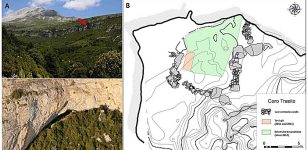Our Understanding Of Human Prehistory And Societies Is Wrong – Scientists Say
AncientPages.com - In many popular accounts of human prehistory, civilization emerged in a linear fashion. Our ancestors started as Paleolithic hunter-gatherers living in small, nomadic and egalitarian bands. Later, they discovered farming and domesticated animals for food and service.
Before long, they progressed to complex societies and the beginnings of the modern nation-state. Social hierarchies became more complex, leading to our current state of affairs.
Credit: Adobe Stock - anibal
“We are well and truly stuck and there is really no escape from the institutional cages we’ve made for ourselves,” writes historian Yuval Noah Harari in his bestselling Sapiens.
A new book — The Dawn of Everything by late anthropologist David Graeber and archaeologist David Wengrow — challenges this narrative. Rather than being nomadic hunter-gatherers, they argue human societies during the Palaeolithic were, in fact, quite diverse.
Today, increasing inequality, polarized political systems and climate change threaten our very existence. We need a deeper historical perspective on what kind of political world shaped us, and what kinds are possible today.
Social flexibility
Ice Age hunters in Siberia constructed large circular buildings from mammoth bones. At Göbekli Tepe, a 9,000 year old site in Turkey, hunter-gatherers hoisted megaliths to construct what may be the world’s “first human-built holy place.”
In Ukraine, 4,000 year-old cities show little evidence of hierarchy or centralized control. And in modern times, hunter-gatherers shift between hierarchy and equality, depending on the season.
To Graeber and Wengrow, these examples speak to the virtually unlimited social flexibility of humans, undermining Harari’s dark assessment about the possibility for social change in the modern world.
As an evolutionary anthropologist and hunter-gatherer specialist, I believe both accounts miss the mark about the course of human prehistory. To see why, it is important to understand how anthropologists today think about nomadic egalitarian bands in the scheme of social evolution.
Human social evolution
In the 19th-century, anthropologists like Lewis Henry Morgan categorized human social evolution into three stages: savagery, barbarism and civilization. These correspond to hunting and gathering, farming and urban life, respectively. These so-called “stage models” incorrectly view social evolution as a steady march of progress toward civilized life.
Scholars do not take stage models seriously today. There is little intellectual connection between stage models and modern evolutionary approaches toward studying hunter-gatherers.
Anthropologists developed the nomadic-egalitarian band model during a 1966 conference called Man the Hunter. According to this model, humans, prior to agriculture, lived in isolated nomadic bands of approximately 25 people and subsisted entirely on hunting and gathering.
Research since Man the Hunter has updated our understanding of hunter-gatherers.
Hunter-gatherers and prehistory
One assumption was that small bands consist of related individuals. In fact, band societies consist of mostly unrelated individuals. And anthropologists now know that hunter-gatherer bands are not closed social units. Rather, they maintain extensive social ties across space and time and sometimes assemble in large groups.
Hunter-gatherers are profoundly diverse in modern times, and they were in the past too. This diversity helps anthropologists understand how the environment shapes the scope of social expression in human societies.
Consider nomadic egalitarian hunter-gatherers like the !Kung in the Kalahari or the Hadza in Tanzania. Being nomadic means it is difficult to store food or accumulate much material wealth, making social relations relatively egalitarian. Group members have equal decision-making power and don’t hold power over others.
On the other hand, sedentary societies tend to have more pronounced levels of social inequality and leave material evidence such as monumental architecture, prestige goods and differential burial treatment.
When these markers are not present, anthropologists can reliably infer that humans were living more politically egalitarian lives.
Palaeolithic politics
Human societies have generally become larger-scale and more complex over time. Popular accounts typically implicate farming in kick-starting the path to “civilization” and inequality. But the shift to farming was not a single event or a simple linear process. There are many paths toward social complexity and inequality.
The Dawn of Everything, along with reviews in cultural evolution and evolutionary anthropology, suggests that complex societies with institutionalized inequality emerged far before the dawn of agriculture, perhaps as far back as the Middle Stone Age (50,000 to 280,000 years ago).
This is a tantalizing possibility. But there is reason to be skeptical.
Complexity on the coastline
Social complexity emerged among hunter-gatherer populations living in resource-rich areas like southern France and the Pacific Northwest Coast of the United States and Canada.
So rich were the salmon runs of the Pacific Northwest Coast, Indigenous peoples could sustain themselves on wild foods while living a sedentary life, even evolving complex hierarchies dependent on slave labour.
Similarly, complex societies could have arisen in the Palaeolithic along rich riverine systems or on coastlines — now submerged by sea level changes — with plentiful marine resources. But there is no unambiguous evidence for sedentary settlements where marine sources are used in the Middle Stone Age.
Collective hunting
Collective hunting is another pathway toward social complexity. In North America, hunters cooperated to trap pronghorn antelope, sheep, elk and caribou. At “buffalo jumps,” ancient Indigenous hunters drove bison over cliff sides by the hundreds. This feat likely required, and fed, several hundred people.
But these examples represent seasonal events that did not lead to full-time sedentary life. Buffalo jumps occurred in the autumn, and success was probably sporadic. Most of the year these populations lived in dispersed bands.
Egalitarian origins
Anatomically modern humans have been around for roughly 300,000 years. There is little evidence of markers of sedentary lifestyles or institutionalized inequality going back more than 30,000 to 40,000 years.
Manda Guéli Cave in the Ennedi Mountains, northeastern Chad. Credit: David Stanley - CC BY 2.0
That leaves a big gap. What kind of society did people live in for most of the history of our species?
There is still strong evidence that humans actually lived in nomadic egalitarian bands for much of that time. Complementing the archaeological evidence, genetic studies suggest that human population sizes in the Palaeolithic were quite low. And the Palaeolithic climate may have been too variable to permit long-term sedentary life, instead favouring nomadic foraging.
This does not mean that humans are naturally egalitarian. Like us, our ancestors faced complex politics and domineering individuals. Egalitarian social life needs to be maintained through active and coordinated effort.
From these origins, an astonishing variety of human societies emerged. Our politics today reflect a small and unusual slice of that diversity. Prehistory shows us that human political flexibility is far greater than we can imagine.
Written by Vivek V. Venkataraman, Assistant Professor of Anthropology and Archaeology, University of Calgary
Provided by The Conversation
This article is republished from The Conversation under a Creative Commons license. Read the original article.
More From Ancient Pages
-
 Early Neolithic High Mountain Settlers Were Busy With Complex Livestock And Farming Activities – New Study
Archaeology | Dec 22, 2023
Early Neolithic High Mountain Settlers Were Busy With Complex Livestock And Farming Activities – New Study
Archaeology | Dec 22, 2023 -
 Ancient Roman Port Discovered Off The Syrian Coast
News | Feb 16, 2021
Ancient Roman Port Discovered Off The Syrian Coast
News | Feb 16, 2021 -
 Is This The Earliest Evidence Of First Human Language?
Archaeology | Mar 12, 2018
Is This The Earliest Evidence Of First Human Language?
Archaeology | Mar 12, 2018 -
 Incredible Find – 3,000-Year-Old Canoe Found In Wisconsin’s Lake Mendota
Archaeology | Sep 25, 2022
Incredible Find – 3,000-Year-Old Canoe Found In Wisconsin’s Lake Mendota
Archaeology | Sep 25, 2022 -
 Extraordinary Kite-Shaped Pictish Ring Found At Moray Fort In Scotland
Archaeology | Sep 5, 2024
Extraordinary Kite-Shaped Pictish Ring Found At Moray Fort In Scotland
Archaeology | Sep 5, 2024 -
 Mysterious People Who Appeared Out Of Nowhere
Featured Stories | Sep 1, 2018
Mysterious People Who Appeared Out Of Nowhere
Featured Stories | Sep 1, 2018 -
 Ancient Dacian Gold Helmet With Piercing Evil Eyes
Artifacts | Jan 4, 2019
Ancient Dacian Gold Helmet With Piercing Evil Eyes
Artifacts | Jan 4, 2019 -
 Neanderthals Vanishing When Homo Sapiens Emerged In Europe Was Coincidental – Are Herbivores The Answer?
Evolution | Sep 29, 2023
Neanderthals Vanishing When Homo Sapiens Emerged In Europe Was Coincidental – Are Herbivores The Answer?
Evolution | Sep 29, 2023 -
 Runes Were Just As Advanced As Roman Alphabet Writing – New Study
Archaeology | Mar 3, 2023
Runes Were Just As Advanced As Roman Alphabet Writing – New Study
Archaeology | Mar 3, 2023 -
 Huge Viking Winter Camp Unearthed In England
Archaeology | May 19, 2017
Huge Viking Winter Camp Unearthed In England
Archaeology | May 19, 2017 -
 Peculiar Neolithic Anomaly Investigated In Scotland
Featured Stories | Apr 27, 2024
Peculiar Neolithic Anomaly Investigated In Scotland
Featured Stories | Apr 27, 2024 -
 Scientists Identify Birds On Magnificent Ancient Egyptian Artwork Found In Amarna
Archaeology | Dec 28, 2022
Scientists Identify Birds On Magnificent Ancient Egyptian Artwork Found In Amarna
Archaeology | Dec 28, 2022 -
 Early Humans May Have First Walked Upright In The Trees 7 Million Years Ago
Human Beginnings | Dec 17, 2022
Early Humans May Have First Walked Upright In The Trees 7 Million Years Ago
Human Beginnings | Dec 17, 2022 -
 3,500-Year-Old Tomb Of Egyptian Goldsmith Discovered
Archaeology | Sep 10, 2017
3,500-Year-Old Tomb Of Egyptian Goldsmith Discovered
Archaeology | Sep 10, 2017 -
 Hidden Tunnel In Tokat Castle – ‘The Dungeon Of Dracula’ – To Open Soon
News | Sep 22, 2015
Hidden Tunnel In Tokat Castle – ‘The Dungeon Of Dracula’ – To Open Soon
News | Sep 22, 2015 -
 Face Of Queen Lady Cao Reconstructed – Unique Look At The First Known Female Ruler In Peru
Archaeology | Jul 10, 2017
Face Of Queen Lady Cao Reconstructed – Unique Look At The First Known Female Ruler In Peru
Archaeology | Jul 10, 2017 -
 Deadly Catastrophe In Pompeii And An Overlooked Piece Of The Well-Researched Disaster
Archaeology | Jul 18, 2024
Deadly Catastrophe In Pompeii And An Overlooked Piece Of The Well-Researched Disaster
Archaeology | Jul 18, 2024 -
 Europe’s Earliest Culture Of Aurignacian People Made Amazing Images With Dots
Archaeology | Mar 5, 2017
Europe’s Earliest Culture Of Aurignacian People Made Amazing Images With Dots
Archaeology | Mar 5, 2017 -
 Gothic Warrior With Rare Sword Unearthed In Thessaloniki, Greece
Archaeology | Apr 23, 2021
Gothic Warrior With Rare Sword Unearthed In Thessaloniki, Greece
Archaeology | Apr 23, 2021 -
 Never-Before-Seen Face Of A Tattooed Tashtyk Man Hidden Behind A Gypsum Death Mask Revealed
Archaeology | Jul 17, 2020
Never-Before-Seen Face Of A Tattooed Tashtyk Man Hidden Behind A Gypsum Death Mask Revealed
Archaeology | Jul 17, 2020


